The Breakdown
Pros
Cons
HJC’s Helmet Building Talents Applied to Update to HJC’s Best Helmet. Did They Improve An Already Outstanding Helmet? Read On.
The HJC RPHA 11 Pro is the update to the popular RPHA 10 Pro. RPHA helmets are a step above the average HJC product line. They are a showcase for HJC’s helmet building talents, according to the company. The pricing is also a step above the average HJC helmet. But the RPHA 11 Pro is a solid competitor to just about any other high-end motorcycle helmet available.
And when you look at it that way, the price is actually fairly reasonable. The RPHA 11 Pro is very light, utilizing a composite shell. Some grams were no doubt shaved because the RPHA 11 Pro loses the Snell certification found on the RPHA 10 and RPHA 10 Pro. It’s comfortable and it has high-quality construction and many different color combinations.
Probably the best feature of the RPHA 11 Pro is the ventilation, which is outstanding. The top vent system, with its unique roller “micro” opening system, pours a huge amount of air on to the rider’s head.
The chin vent also has a special feature, with an extra slider on the inside of the chin bar to control air flow massive amounts down to a trickle.
About the only downside of the helmet is noise control. It’s not too loud at average speeds or when riding motorcycle without a windscreen or fairing. But the composite shell does seem to resonate with buffeting sounds and some windscreens can a bit more noise than we’d like.
Overall, the RPHA 11 Pro is an outstanding helmet however and it surprises in many ways.
See Also: Helmet Buyers Guide, Helmet Review Home and all HJC Helmet Reviews.
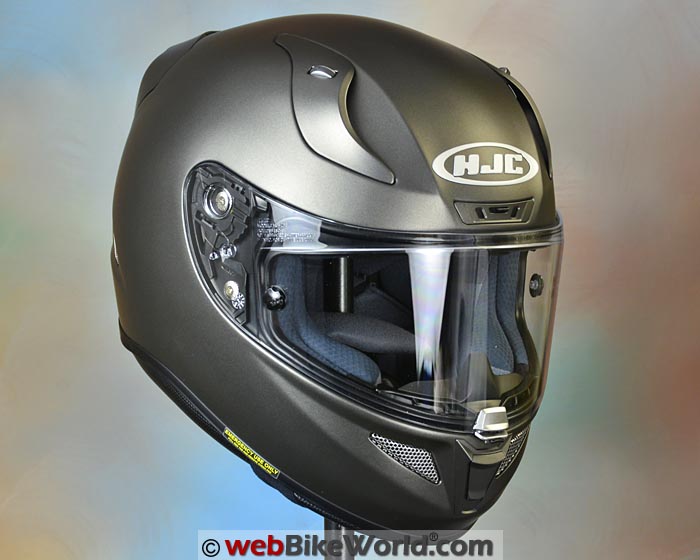
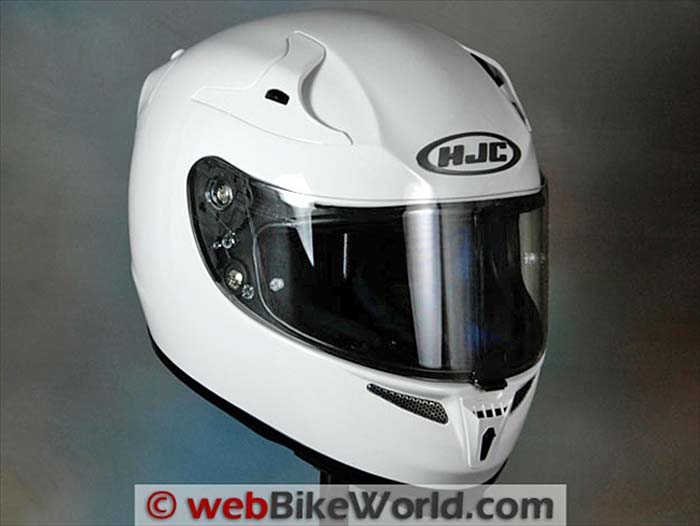
Introduction
The HJC RPS 10 (review) (shown above) was first introduced at the 2009 Dealer Expo in Indianapolis. At that time, even the HJC reps at the show couldn’t explain what the new RPS helmet line was all about and how it would fit into the HJC lineup. The RPS 10 was known as the RPHA 10 in Europe and shortly thereafter, HJC switched from RPS to RPHA in the U.S.A. also.
RPHA is said to stand for “Revolutionary Performance Helmet Advantage”, which is a mouthful in any language. The RPHA helmet line for HJC is sort of like Lexus is to Toyota. The helmets have the same excellent DNA but they’re jacked up a few notches in specs, quality and performance.
Since its initial release, the RPHA 10 became fairly popular but it has remained mostly unchanged since the introduction. In the interim, to keep the line fresh the RPHA 10 Pro and RPHA ST were introduced, along with the RPHA Max flip-up helmet (review) and the RPHA X off-road helmet.
In fact, the RPHA ST, RPHA 10 and RPHA 10 Pro are still listed in the HJC lineup, as a “good/better/best” hierarchy. Whether or how long they’ll remain in the lineup is unknown; possibly only until the existing stock is gone, although a new RPHA ST colorway was recently announced, which indicates continued support for the “10” lineup.
It also remains to be seen whether other versions of the RPHA 11 Pro will be produced. One interesting fact to note is that the RPHA 11 Pro does not have a Snell M2015 certification, although it is labeled as having an ECE 22.05 (report) approval. The RPHA 10 Pro is Snell M2015 certified and the RPHA 10 is Snell M2010 while the RPHA 10 is DOT only.
What Is RPHA?
HJC states that the RPHA helmet line “showcases our technical capabilities and innovations”. RPHA probably isn’t the most memorable name for a motorcycle helmet and other than the original RPS 10, you’ll only find an HJC logo top center on the RPHA helmets.
HCJ also said “What sets our RPHA 10 apart is that it offers all the features of high-end helmets at prices the average consumer can afford, an accomplishment our high-end competitors have not been able to do.” While this may sound only like a marketing department boast, it’s pretty near the mark in our opinion, because the RPHA 11 Pro is a solid competitor for any other high-end helmet.
Regarding the pricing, the RPHA 11 Pro has a list price of about twice the average HJC helmet, but half of what you’d pay for a Shoei, Arai, Schuberth, etc.
And here’s the secret: the RPHA 11 Pro beats them all when it comes to ventilation and it weighs less as well.
Shopping Now? We Recommend
webBikeWorld has worked closely with RevZilla over the years to provide our testers with products to review. In addition to being a great site to shop from, they’re also a great partner. Both Amazon and Revzilla have a big selection of helmets from the great helmet manufacturers.
RevZilla
Free shipping on orders over $40
30-day no-nonsense return policy
Excellent selection of all major brands
Awesome pricing
Paint, Graphics and Overall Quality
The RPHA 11 Pro — indeed, the entire RPHA series — comes in a wide variety of colorful graphics, including Spiderman, Venom versions and more. There are fewer choices for solid colors; just black, white and the “Semi-Flat Titanium” shown here. It would be nice to have a choice of red, orange and yellow. And maybe blue and green and…
The shell is made from something you won’t find on pedestrian HJC helmets — it’s HJC’s “Premium Integrated Matrix Plus (PIM+)”, a composite blend of carbon fiber, Aramid, fiberglass and “organic non-woven fabric.” The composite shell means the RPHA 11 Pro is very light weight but with a solid feel.
The overall quality is outstanding, although only long-time webBikeWorld readers will know that just about everything has excellent quality today, compared to 18 years ago when webBikeWorld started.
Back then, using the words “quality” and “motorcycle gear” together really meant something, because compared to now, well, there was a lot of junk for sale, including (and especially) helmets. In any case, the overall finish and also the moving parts on the RPHA 11 Pro show attention to detail and operate smoothly.
The switchgear is especially noteworthy and the roller top vent openings — an RPHA signature feature — make a noticeable difference. You’ll need that amount of control for the top vents, because the air literally pours into this helmet. And how about the chin vent, which has dual controls with a slider the outside and the inside? We’ll get into all of that in the ventilation section below.
More Details
The liner is the latest HJC type, similar to the new HJC DS-X1 dual-sport helmet we reviewed just a couple of weeks ago. It’s apparently a new design, different from previous HJC helmets we’ve reviewed.
The liner is fully removable and the RPHA 11 Pro includes the emergency release straps on the cheek pads.
An owner-installable chin curtain is also included; it’s very nicely made but be sure to follow the instructions explicitly when you install it. If you do, it’s a breeze but if you don’t, you’ll struggle with it (don’t ask).
Score: We give the HJC RPHA 11 Pro an “Outstanding” rating for overall quality. See the Summary Table at the bottom of the page for a description of our rating system.
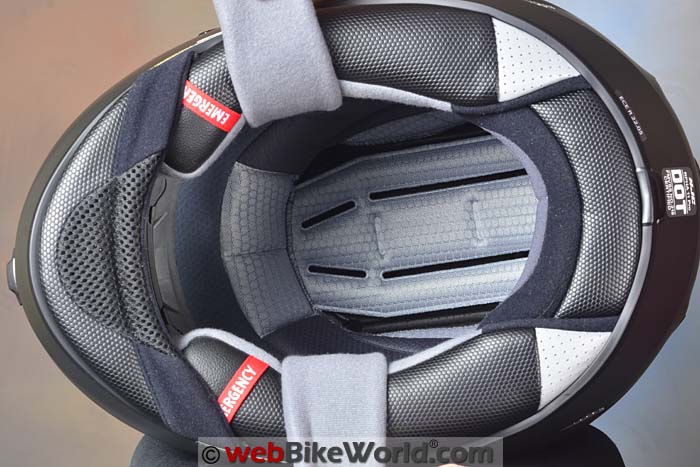
Helmet Fit and Internal Shape
We initially assumed that the RPHA 11 Pro would have a “Slightly Narrow” internal shape (according to the webBikeWorld Motorcycle Helmet FAQ), which is typical for a “racing” oriented sport helmet. That’s because most of the other brands of high-end racing helmets have this type of internal shape, which is also sometimes known as the European or ECE shape. But in a surprise, the internal shape feels much more “Neutral” than we imagined. In fact, several other reviewers even called the shape “Round”.
This “Neutral” internal shape is very similar to another new HJC helmet, HJC DS-X1 we reviewed recently and it means that the RPHA 11 Pro is also a good match the majority of rider head shapes. Also, there are additional liner and cheek pad options which allow you to do a bit of customizing.
Since the RPHA 11 Pro is categorized as a racing helmet, we also suspected it would have race helmet sizing, which typically runs small, and that assumption has proved correct.
The shell has a slight taper towards the bottom but it’s easy to pull over the head. The sizing does seem small, however, by about one full size. For example, the size XL shown here fits much more like a typical size large and even then, the XL RPHA 11 Pro feels pretty tight, so a thinner (larger letter size) cheek pad option may be necessary for some owners.
(As an aside, we also noted this sizing difference with the HJC DS-X1 we reviewed recently as well, so perhaps HJC is starting a new company standard for helmet sizing.)
HJC lists both the DS-X1 and RPHA 11 Pro in size L as 58-59 and the XL as 60-61. But be careful here as well, because some of the retailers have the size XL in the RPHA 11 Pro listed as 61-62, which is definitely not correct.
The liner also appears to be the newer HJC type, similar to the liner found in the DS-X1, with the “bumpy” hexagon pattern on the vinyl. It’s comfortable, although the padding feels a little thinner than the DS-X1, but this may vary, depending on the head size vs. shell size. The RPHA 11 Pro comes in three shell sizes: XS-S, M-L and XL-2XL.
Bottom line? It’s a good thing we ordered an XL, because a size L probably feels more like a size M.
More Liner Details
The liner in the DS-X1 is called the HJC “Supercool”, while the liner in the RPHA 11 Pro is the “Multicool”, which is claimed to have better moisture-wicking and drying than the previous RPHA 10 liner version.
Ear Pocket Notes
Also, despite being a racing helmet, the ear pockets in the RPHA 11 Pro are molded for speakers. But, the vertical dimensions of the ear pockets are slightly shorter than expected, so you may have to work the helmet around to get the tops of your ears to set correctly.
Eyeglass Fit
The helmet is also “eyeglass friendly”, with recessed and specially lined channels on either side at the top of the cheek pads. This wasn’t expected and it does work, making it easy to slide a pair of sunglasses or eyeglasses inside the helmet.
Intercom Fit
It should be possible to install an external intercom clamp, although the gap between the shell and the cheek pads is tiny and tight. You’ll have to use a boom mic inside, however, because of the large chin vent with the secondary slider on the inside of the chin bar. We said this about the DS-X1 and it goes for the RPHA 11 Pro as well: it’s an HJC, so it looks and performs better than the price would indicate.

More information on helmet fit can be found in the webBikeWorld Motorcycle Helmet FAQ page. Also, see the chart that lists the helmet weights of webBikeWorld reviewed helmets and also by shape on the webBikeWorld Motorcycle Helmet Shapes page.
Score: We’ll give the HJC RPHA 11 Pro an “Excellent” rating for shape, comfort and thick padding.
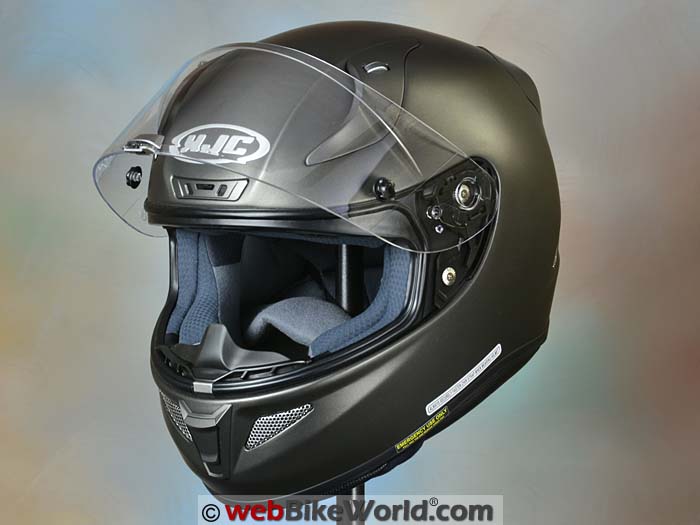
Face Shield, Eye Port and Outward Visibility
The original RPS 10 introduced the big central spring-loaded clip face shield release. It was very large back then — large enough to be somewhat annoyingly present in the wearer’s line of sight. That feature has remained over time, but either we’ve become used to it or the release is now smaller — or a combination of the two.
In any case, it works well. It’s easy to squeeze the bottom half to release the face shield, even when wearing gloves. There’s also a tiny sliding horizontal lock in case you need even more security, but the clip works so well, you probably won’t. Unfasten the release and the face shield will open to a first small defogging position, which works very nicely to let in plenty of air without feeling like a tornado is also about to enter.
The face shield has a total of 5 detents and it’s very easy to remove, as illustrated in our video below. In fact, it’s among the easiest face shield changes of any helmet we’ve reviewed.
Freebies Included
Our RPHA 11 Pro came with a spare dark tinted face shield also, which is included with the helmet and that has to be at least a $40.00 option. An anti-fog insert is included in the box also and if you live in a damp climate, you’ll probably need it.
The city defogging position works perfectly to keep the face shield fog-free, but as soon as the face shield is secured, the fogging begins.
So apparently the standard face shield is not treated with any type of anti-fog coating, which is expected for this type of helmet.
Outward Visibility
The horizontal and vertical sight lines from the eye port are good, but not outstanding, especially after coming directly from the HJC DS-X1 which, although not really comparable because it’s a completely different class of helmet, has incredible outward visibility.
There’s a slight angle on either side of the RPHA 11 Pro eye port, although over-the-shoulder head checks aren’t too compromised. Bottom line here is that the outward visibility is about average to maybe slightly better than average.
One final note on this topic, there’s a full surround gasket on the eye port and once the face shield is closed and locked, water is kept out.

Score: The RPHA 11 Pro face shield and outward visibility gets an “Excellent”, all things considered.
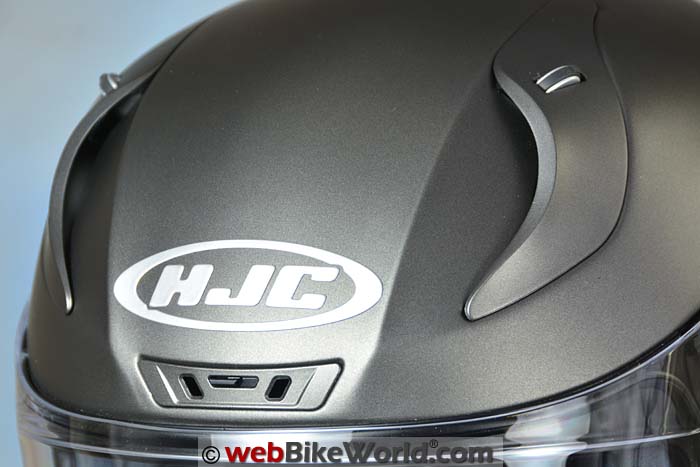
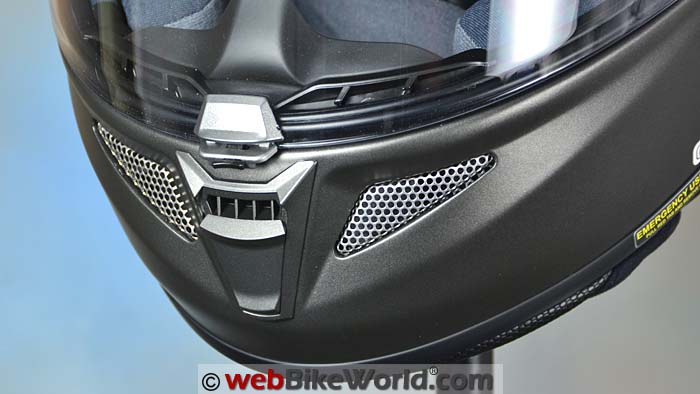
Where to find the HJC RPHA 11 Pro
webBikeWorld has worked closely with RevZilla over the years to provide our testers with products to review. In addition to being a great site to shop from, they’re also a great partner. Both Amazon and Revzilla have a big selection of helmets from the great helmet manufacturers.
RevZilla
Free shipping on orders over $40
30-day no-nonsense return policy
Excellent selection of all major brands
Awesome pricing
Pro Ventilation and Air Flow
OK, let’s get to the best feature of the RPHA 11 Pro: the ventilation. Simply put, it’s outstanding — in fact, it’s about the best you’ll find in any full-face helmet. The top vents are especially noteworthy; the liner is perfectly slotted to allow unencumbered air flow through the top vents and down through the EPS on to the rider’s head.
It’s very rare indeed when there’s so much ventilation that we actually have to close the top vents and with the RPHA 11 Pro, that’s definitely the case (at least in our cool winter weather). This is where those roller “micro” top vent adjusters come in very handy. They actually roll through 6 detents and allow perfect incremental control of the air that pours in through those top vents. With top venting like this, it makes you wonder how most of the other helmet manufacturers can get it so wrong. That’s because too many helmet designs have a head liner that actually blocks the air coming through the vent channels in the EPS. Sounds crazy, but that’s the situation with way too many motorcycle helmets.
Chin Vent
The chin vent of the RPHA 11 Pro is just as good. It has a single slider in front, flanked by perforated metal vents on either side, much like the HJC DS-X1 design (possibly a new standardized HJC ventilation design?). The kicker is that the chin vent has a separate sliding mechanism on the inside, which opens 3 vent ports through the chin bar for ultimate air flow.
Or, you can control the amount by moving the inner vent slider to your desired position. Another “Why didn’t I think of that?” idea that’s simple yet very effective.
Bottom line? The ventilation system on the RPHA 11 Pro is one of the best you’ll find in any full-face helmet and for many riders, the performance of the ventilation system is the only justification you’ll need to buy this helmet.

Score: We’ll rate the ventilation system of the HJC RPHA 11 Pro as “Outstanding”.
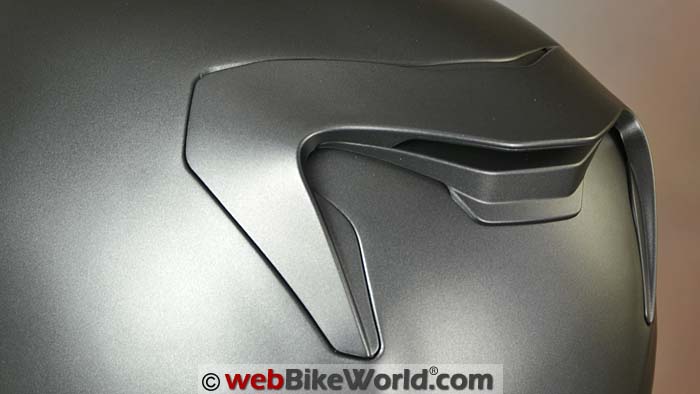
HJC RPHA 11 Pro Sound Levels
In general, the RPHA 11 Pro is quiet enough and perhaps we can rate it as average to slightly better than average when riding a “naked” or unfaired bike. But the composite helmet shell seems to have a slight quirk. It seems to resonate more than polycarbonate, a material which usually helps dampen some of the noise.
The resonating effect is noticeable when you walk wearing the RPHA 11 Pro; you can hear each foot step thumping in the helmet. We’ve noticed this before on other helmets with fiberglass or composite shells, so it could be a combination of the shell material along with the EPS, the lining and the construction.
This resonance can also transmit some extra wind noise when the helmet is being buffeted by the air, like when you’re riding behind a mid-height windscreen that directs turbulent air around the bottom of the helmet.
The noise isn’t unbearable by any means, but it is something to be aware of. If you’re riding an unfaired bike, you probably won’t notice this and the helmet’s noise transmission levels aren’t too bad actually. And considering the amount of air flowing into this helmet, a slightly elevated noise level is something we can live with. We’re not the only ones who have kind of a 50/50 take on RPHA 11 Pro noise levels; you can read through some of the owner comments in the various forums and retailers and find opinions on one side or the other.
Note that we always wear high-quality, correctly fitted disposable ear plugs when reviewing motorcycle helmets, so your results will certainly vary from ours if you don’t.

Note that our helmet evaluations are a combined effort of several riders over time on different types of motorcycles with and without windscreens. Evaluators wear correctly fitted, high quality ear plugs (even when evaluating motorcycle intercom systems). Always protect your hearing when riding a motorcycle. See the wBW Earplug Reviews for more information on choosing and wearing earplugs.
Note also that perceived noise levels will vary, depending on the individual. Noise can be caused by many factors, including helmet fit, the type of motorcycle and windscreen, wind speed and direction and even the rider’s clothing.
For more information on helmet noise, visit the wBW Motorcycle Helmet Noise page.
Score: We’ll give the HJC RPHA 11 Pro a “Very Good” rating for noise control.
wBW Video: HJC RPHA 11 Pro Helmet
Helmet Weight
This RPHA 11 Pro in size XL weighs in at a very light 1502 grams, (3 lbs., 5 oz.), which puts it in the lightest 10% of the 300 or so helmets we’ve reviewed on webBikeWorld.com. This is an excellent showing, considering the helmet’s comfort, internal padding and liner and yes, even the relatively not-too-bad noise levels.
Note that all of the helmets reviewed on webBikeWorld have been weighed and the weights are available on the wBW Motorcycle Helmet Weights page. See also the chart that lists the helmets by weight and shape on the wBW Motorcycle Helmet Shapes page.
Score: We rate the HJC RPHA 11 Pro as “Outstanding” for its very low weight and good balance and aerodynamics.
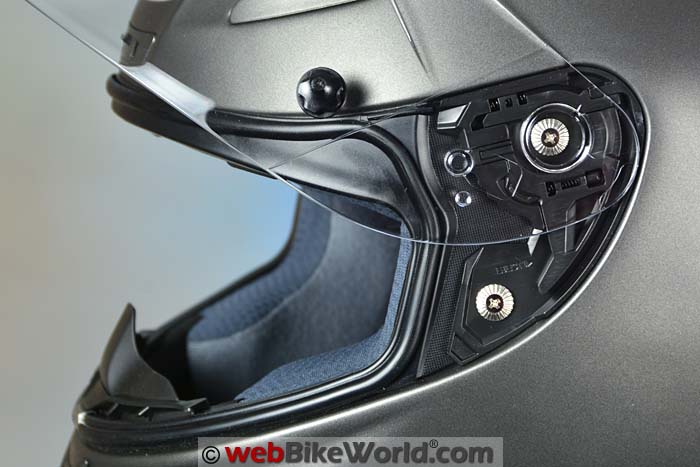
Miscellaneous
The RPHA 11 Pro has a double-D ring chin strap attachment system with a plastic snap to hold the excess and adequate chin strap padding. The helmet meets the DOT standard in the U.S.A. and ECE 22.05 in Europe. Sizes range from XS to 2XL.
Picks…
- Outstanding build quality.
- Outstanding ventilation.
- Very comfortable.
- Solid feel.
- Very light weight.
- Good face shield design.
- Reasonable price.
Pans…
- Slightly small ear pockets.
- Some noise control issues.
- More solid colors?
Conclusion
The HJC RPHA 11 Pro was a big surprise to us, as we didn’t know what to expect based on our experience with the original RPHA 10, albeit 7 years ago. But the combination of outstanding ventilation — which really is about the best you’ll find in a full-face helmet — the light weight and solid build quality of the RPHA 11 Pro should make this a definite choice for anyone searching for the “perfect” full-face high-end helmet.
There really isn’t much of a downside, other than perhaps the minor noise control problems which probably seem more substantial than they really are only because everything else on this helmet is so good.
Our only wish is minor: it would be nice if it came in more solid colors, which could also help attract more, ahem, “mature” sport-touring or touring riders who might otherwise look elsewhere because they’re not interested in the more radical graphic designs.
This is definitely the case with the RPHA 11 Pro which, when all things are considered, has impressive performance at a mid-range price (at least for the solid color version) that matches helmets costing twice as much and more.
More webBikeWorld:
wBW Review: HJC RPHA 11 Pro Helmet
Buy the HJC RPHA 11 Pro
webBikeWorld has worked closely with RevZilla over the years to provide our testers with products to review. In addition to being a great site to shop from, they’re also a great partner. Both Amazon and Revzilla have a big selection of helmets from the great helmet manufacturers.
RevZilla
Free shipping on orders over $40
30-day no-nonsense return policy
Excellent selection of all major brands
Awesome pricing
Reader Comments
From “G.W.” (March 2017): “I am currently in the market for a new helmet to replace my aging Shoei Qwest (review). I’m torn between another Qwest, a Shoei RF-1200 (review), and the HJC RPHA 11 Pro. I’ve tried them all on, and find them all comfortable, so it’s mostly down to features. I really like the RPHA 11 Pro (especially since it’s cheaper and includes the tinted visor and Pinlock, so it would be a one-and-done purchase). My only hesitation is cold weather riding.
I currently ride with my Qwest into temperatures ranging from ~35 degrees to 100 degrees, and find it suitable for this range. I can seal the helmet well by closing both front and rear vents and minimize cold air intrusion. Most reviews focus on how well helmets vent, but I am curious about how they handle this cold weather. Can the RPHA 11 Pro be sealed off well enough to handle cold temperatures?
The front vents can close, but the rear vents cannot, and I’m curious how much air the chin vent may let in, or whether the front vents fully seal or if air seeps through?”
Rick’s Reply: Actually, I think the RPHA 11 Pro has very good sealing in the vents. The chin vent especially has the double seal, with the slider on the outside and a second slider on the inside, as we described in the review. This definitely stops any air flow, other than what seeps up from underneath the helmet. Top vents also, it’s winter here and we’ve been wearing the helmet in 40 degree weather and it has such good ventilation that the top vents have to be closed or only opened to one notch on the roller. It seals tight, so there’s no problem there either.
In fact, I’d say it seals better than most of the other full-face helmets we’ve reviewed. Also, I think the rear exhaust vent should always remain open, actually especially in cold weather. You do need some air to move through, otherwise fogging will increase. Note that you will need the anti-fog insert however in cold weather, because the standard face shield is apparently untreated, so when it’s locked shut, it will fog.
In colder weather here, riding behind the small windscreen on the Kawasaki Versys 650 LT (Blog), I keep the chin vent open half way, none to one notch on the top vents and the face shield open to the city defogging position.
From “S.E.” (March 2017): “Great write-up as always. I haven’t seen the RPHA 11 but I did race with the (RPHA) 10. In my opinion, the RPHA helmets really aren’t street helmets and are really tuned for the track as you mentioned in some points. A lot of the negatives aren’t even a factor in racing. In the 10, the rather small eye port is a hindrance at best on the street where you are head on a swivel looking for cars, but on a track where you’re mainly looking straight through the port and turning your head through the turn it’s not an issue. Upward visibility in a full racing tuck position was fine.
The helmet was comfortable and I liked mine…until I had a high speed crash after getting pushed off the track on the outside of a turn at 70+ mph. My head overall was fine but my mouth and front teeth took a huge hit and I was afraid I had knocked some out until I felt with my hand to confirm I still had them.
My buddy however wasn’t so lucky and lost several in a fast glancing crash into a tire wall and now has several false teeth in front. He also tells that a previous crash had resulted in a large hit in his mouth. Given how close the chin bar is to the face it’s not surprising now. As a result of our experience we have quit using the RPHA helmets and gone to other brand and model with more room in the front of the helmets.
But I’ll agree that the RPHA is a step above other HJC models on fit, finish, quality, and features. And it’s a relative bargain for the features you get for the price.”
Rick’s Reply: I’m usually pretty sensitive to chin bars that are too close to my face, which can be a problem for me due to the shape of my head. I don’t notice this as an issue in the RPHA 11 Pro however.



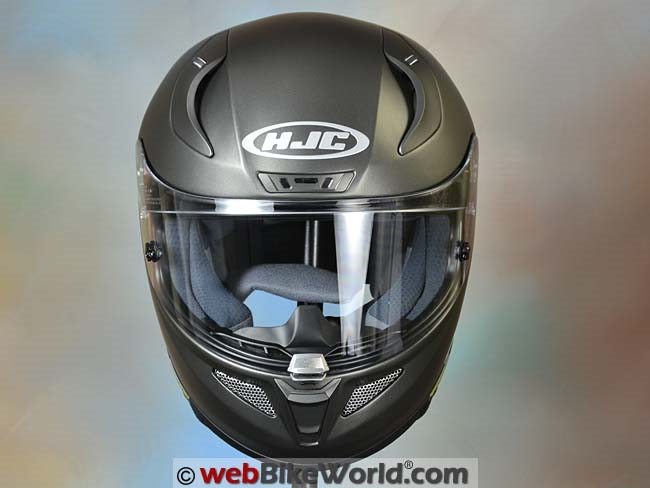

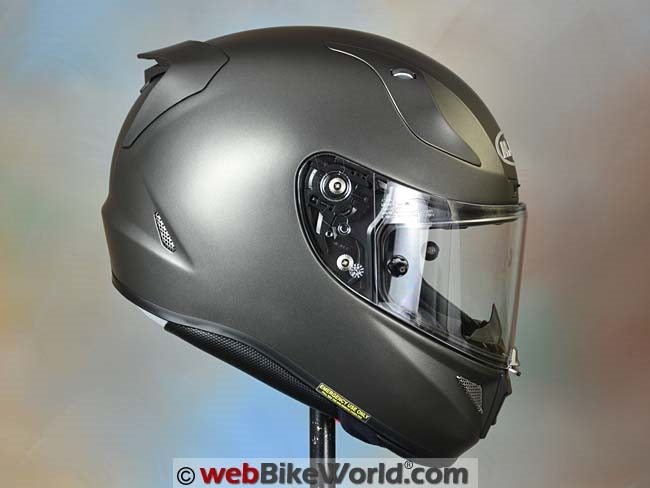
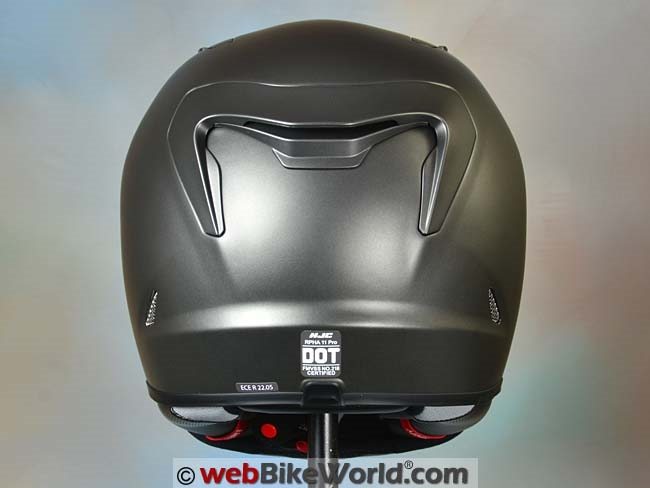
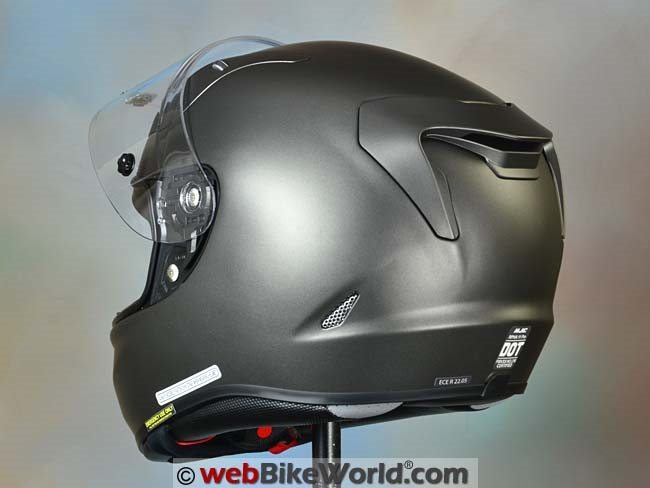

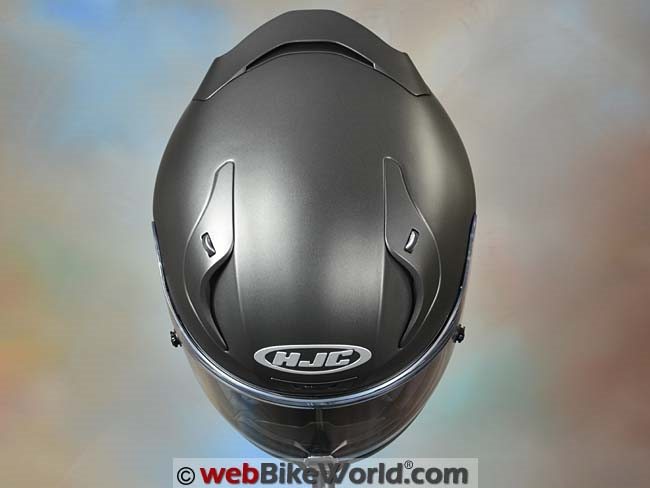





Hello, I have a RPHA Vermo 11 helmet, size medium, which has 40mm cheekpad inserts. They are the emergency pull out cheek pads. The helmet is too tight on me and I cannot wear it with this size cheekpad in. I have tried getting 35mm cheekpads here in the UK, but have been told they do not do them. Do you do 35mm cheekpads that I can buy and use on this helmet? If you do could you please send me a picture of them so I can check they are the right ones? Would you ship to the UK, if so can you tell me what the price would be to buy and ship please?